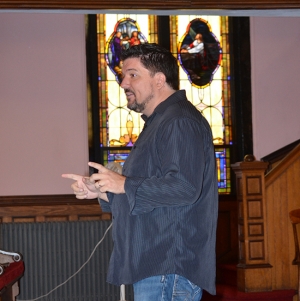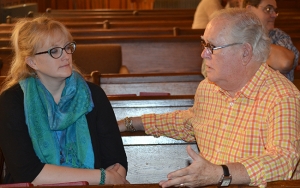news article
Moore: Metaphors are like the glue that holds a good sermon together
September 25, 2014 / By Christian Vischi / .(JavaScript must be enabled to view this email address)
There is a common fallacy out there: "If you want a more creative worship service, add a screen. Or two. Just follow that trend and you’ll add the technological pizzazz that your worship desperately needs."
 Jason MooreBut creative worship specialist, author and worship coach Jason Moore of Midnight Oil Productions is here to dispel that notion.
Jason MooreBut creative worship specialist, author and worship coach Jason Moore of Midnight Oil Productions is here to dispel that notion.
“Installing screens in worship might be the biggest trend of the past 10, 20 years, but it doesn’t really transform anything in worship because there is a huge difference between technology and culture,” Moore said.
“Image is just a part of the culture that we live in.”
Moore was in the area Sept. 8-11, 2014 to offer four one-day workshops titled Make Worship More Creative to Upper New York members.
The creative worship specialist said there is a huge disconnect between the way screens are used in church and the way screens are used in everyday life. Screens shouldn’t duplicate, they should enhance.
“We think of the screen as if it is a giant piece of paper, and we take everything that used to be in the bulletin, the hymnal and the Bible and we put it on the screen,” Moore said. "But it is not a piece of paper.”
The key, according to Moore, is to start thinking about an “image-based way to use your screen.”
According to the Visual Teaching Alliance, 65 percent of the population are visual learners. Visual aids can help increase learning by up to 400 percent.
“Image is a native language of our brain. It takes more mental energy to read text; our brain has to convert text to images in our brain. So when we use images in worship we are speaking in the native language of our brain," he said.
There needs to be a shift from text to image, Moore said.
If you make that shift, Moore said, “metaphor is the way to do it today.”
“Metaphor is a tangible way of expressing an abstract story, thought or idea … a doorway to truth,” he said.
Why use a metaphor? Because it makes the message easier to understand, it makes it easier to retain, and because it was Jesus’ model. But that doesn’t mean we can use Biblical metaphors in the 21st century.
 The Rev. Amy Gregory, pastor at the Greene United Methodist Church, meets with Michael McCollough, a member at Norwich's Broad Street UMC, during a small group breakout. (Photos by Christian Vischi)“The problem with using first-century parables in 21st-century culture is that you have to explain them to (help people) understand what the truth is. The best metaphors require very little information,” Moore said.
The Rev. Amy Gregory, pastor at the Greene United Methodist Church, meets with Michael McCollough, a member at Norwich's Broad Street UMC, during a small group breakout. (Photos by Christian Vischi)“The problem with using first-century parables in 21st-century culture is that you have to explain them to (help people) understand what the truth is. The best metaphors require very little information,” Moore said.
“When we use metaphors from the culture and we do the work of redeeming those metaphors – and that is the key … the culture then becomes a reminder of the Gospel.”
For example, you could use sharing a lemonade as a metaphor for sharing the Gospel message.
Imagine it is a hot summer day and you are relaxing on a porch with a friend. Their spouse brings out a pitcher of ice cold, freshly squeezed lemonade. Your friend sits there sipping away as you look at the mercury topping triple digits. You finally inquire: “May I have a glass?”
They give you a puzzled look and reply, “Oh, I am so sorry. I was worried that you didn’t like lemonade, and I didn’t want to jeopardize our friendship by offering you something that you wouldn’t like.”
To draw that connection to offering the Good News during worship, everyone could be given a lemon prior to the service to share with a neighbor; the children’s message could include a lemonade-making demonstration; and you could serve lemonade following the service. The ultimate goal being to “redeem” lemonade, to make that lemonade a reminder of the importance of sharing the Gospel.
If it is done well, “When (they) encounter that thing, the truth is so instilled in that object that it will come back again,” Moore said.
So what are some steps to follow when putting your imaged-based metaphor on the screen?
“There are six principles for design,” Moore said, starting with your metaphor – “the glue that makes it stick.”
- Use references. This doesn’t mean a citation for a statistical reference in your sermon. Look at other artwork – slides, photos, logos, videos, splash pages – that are out there and use the essence of one that moves you in your own work.
- The composition is the way the piece is organized; if there is too much chaos it is too difficult to understand the message.
- Treatment is similar to spices added to a beloved recipe: too much or too little can ruin a masterpiece.
- Consistency: Tell just one story throughout the whole service, but you can vary the multi-sensory worship experience through music, dance, a skit, a video and the sermon.
- Texture or overlays are features added at the end, like a faux antique finish.
- Fonts are the “neglected stepchildren of design,” according to Moore. “Fonts are an element of design that are as important as anything else.”
What it boils down to, Moore said, is that “Creative worship is more than screens. It is more than words, it is a synthesis of them all coming together.”
You can follow Moore on Twitter @midnightoilprod.
Resource recommendations from Moore for clergy and church leaders ($ denotes not a free resource):
- Christian Video Licensing International $ – CVLI provides legal coverage for churches and for other ministry organizations to show motion pictures and other audiovisual programs intended for personal, private use only.
- Sermon Spice $ – Sermon Spice features sermon illustrations, worship backgrounds and more.
- Worship House Media $ – WHM offers worship media, including a range of video illustrations, mini movies, worship song tracks, motion backgrounds, and Christian pictures.
- Gimp Shop – This site calls itself the “free alternative to Photoshop.”
- Audio Jungle $ – More than 198,000 audio files are available from Audio Jungle, from worship music to sound effects.
- Shockwave Sound $ – Another website featuring music and sound effects.
For a variety of free resources, visit Upper New York’s Graphics Resources page.